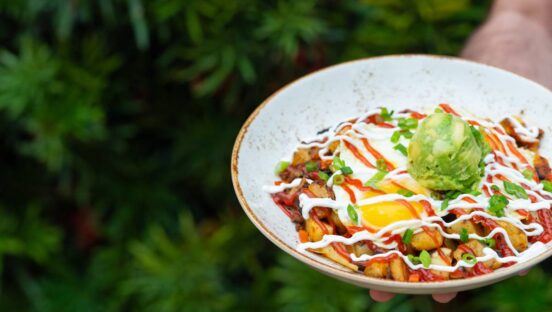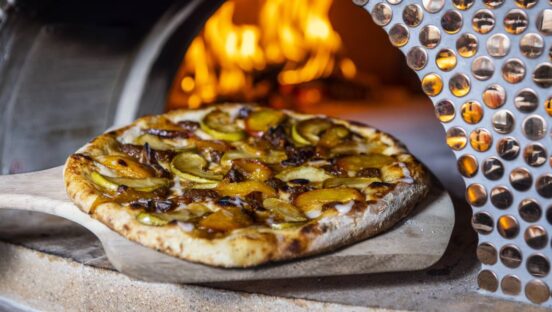














Despite this being my third National Restaurant Association Show in as many years, I still managed to walk through the wrong door on day one. I somehow arrived at an adjacent building, about 170,000 steps from the South and North Halls, and the swath of people who invade them each May to discuss trends, insights, and tout the latest products in the most dynamic (in my opinion) industry out there. By the time I found the action, the same reality hit me as always: You can attend this show 30 times, like some people here at QSR/FSR have, and probably still feel like you’ve crash-landed on a new planet. Before I dive into my top picks for products and platforms I came across, here are some quick takeaways:
The tech section, in year’s past, has felt like a giant point-of-sale pitch to me. I think I heard as many solutions for delivery as I did for payment this year (often they went hand-in-hand, but still that was a noticeable change from the common course).
Operators want to solve the third-party delivery issue from a lot of fronts. We get caught up on the 30 percent commission, but there are so many additional challenges. Probably the most vivid point an operator made to me: When a guest orders from an aggregator, they’re ordering from the third-party company, not you. Protecting brand value, and the data that would have come with it, is as important as guarding margins. Self-delivery—that would be my big bet for round 2 of this movement.
Convenience. A lot of the equipment I came across was all about speed. I don’t think I’ve ever seen so many devices capable of producing food in such little time. And every time (it seemed), the point was, menu made-from-scratch items in no time. That almost seems contradictory, doesn’t it? But that’s science for you, and it’s an exciting opportunity for operators.
Now on to the items. Here were 14 of the best products I found on the floor this year. Pictured is Libbey.
My first job: I walked into a gym and asked if I could hand out flyers. Does anybody do that anymore? One of the selling points of mobile ordering and kiosks to Gen Z and millennials is the lack of human interaction. I’m not even sure how many people talk on the phone to friends, let along strangers these days. With that said, what does this reality do to the labor market? Sahil Sahni parked outside malls and asked people how they would like to be hired. What he came away with was an idea to leverage artificial intelligence to improve the recruiting process on both ends. It uses conversational AI to fully automate the end-to-end recruiting workflow by engaging through texting over mobile and web. Through the process, it will fit talent for the best role, automate interview scheduling and post-interview interactions, drive retention through post-hire check-ins, and gather actionable insights to improve overall recruiting performance.
Brinker, the parent company of Chili’s and Maggiano’s, uses it. So does Five Guys and Arby’s. In Brinker’s case, AllyO helped the company achieve a 91 percent application completion rate and 4:1 interview-to-hire ratio. The company has scheduled more than 10,000 interviews to-date through the service. AllyO has reduced time to hire by 83 percent, Sahni said, across the board. Ninety-four percent of those who use it actually finish the application. As Sahni pointed out, a much different result from those paper applications that disappear into a folder. I ran through the software on my phone. Basically it works like this: You text a number (in Brinker’s case the software is loaded right onto their site) and it replies back. The back-and-forth continued, asking everything from availability to experience to which coffee uses the most foam (I was testing a theoretical Starbucks in a demo). By the time it was over I had an interview schedule to choose from. If you’re working in high volume hires, and don’t want to overload the recruiting budget, this is a pretty exciting piece of tech.
Sterno Products called its new SpeedHeat Flameless Heating System a game-changer for drop-off catering in quick service. The goal was to solve three main issues: the risks associated with unattended open flames, incorrect product setup, and food served at least than ideal serving temperature (cold). What this product does is take two simple, water-activated packets and plastic base trays, and then produce high-heat steam for about an hour or so. Crack open a bottle of water and go. A restaurant can now cater hot food with minimal setup, and the other party can just toss the equipment when it’s over.
The need for a complicated setup team, or an on-site catering squad, is taken out of the equation. No kitchen equipment or power outlet required. Wire racks are gone. This is ideally designed for, say, an office luncheon, or quick pre-event meal. Besides lowering the cost, the product opens a catering window for those quick-serve concepts that were worried about the temperature-controlled integrity of their food. It eliminates having to send a cold sandwich tray to every request. As more and more brands add mobile ordering to their catering platforms, this kind of versatility, low-risk and low-cost kind of option is going to become even more valuable.
Mark Goloboy, who was kind enough to wait around while I got lost trying to find the so-called “recharge lounge,” said something I found interesting. “We want TripAdvisor to become habitual,” he noted. It’s probably safe to assume the majority of people around the global equate the platform with hotels and travel. It’s for tourists, right? Both of those things are true. But why can’t TripAdvisor evolve into more of a day-to-day engine for locals? The company has taken plenty of steps to make this happen, especially on the restaurant-review side. TripAdvisor has featured reviews since 2004 and has grown to more than 4.6 million listings. After acquiring TheFork (a reservations leader) in 2014, this service ramped up. TripAdvisor’s product for restaurant owners arrived two years later. In January 2017, TripAdvisor unveiled Premium, a subscription product for restaurants that allowed operators to take control of their pages unlike ever before. A storyboard at the top gives restaurants the chance to create a video, or rotate pictures and videos of their choice (goodbye half-eaten waffle shot taken by someone’s flip phone).
They could move up a favorite review, show a top three reasons to eat here window, and even check analytics. Now, and we’re only about six months in, restaurants owners have the ability to purchase ads from TripAdvisor that can keep it from getting lost in the pool. Picture it this way: If you’re a great Chicago restaurant, where does that rank in the top places to eat on the site? Being 50th is still exceptional, but how many users will get that far? The sponsored ad placement for TripAdvisor is promoted via popularity search results, cuisine and category shelves, and localized, in destination. Want to pop up in fine-dining? You can make that happen. When diners search for restaurants in an operator’s area, the owner can use an ad to grab their attention and show up in key locations, including the top spot. Owners also only pay for the clicks they get—no commitment, hidden fees, and an ad can be cancelled at any time. Goloboy said, while still early, restaurant owners have taken quickly and fervently to the option. Given that TripAdvisor is linked to many third-party delivery companies, buying an ad can be a streamlined and straight line to a sale for operators.
Ecolab’s SMARTPOWER Program was showcased to me by an Ecolab team in white coats, which felt right. There’s patented chemistry, after all. Ecolab, after visiting 300 kitchens in 21 countries, set out to create a system capable of more than dishing out sparkling glasses. The team discovered that changing patterns in global diets are resulting in more proteins on menus, while there has been a decrease in the amount of water and variations in the quality of water used to clean them. SMARTPOWER was invented to fix this. In addition to cleaning, it reduces labor, water, and energy costs. It still cleans to the next degree, though. We were showed plates washed over and over, and then those washed repeatedly with Ecolab’s program. As you might imagine, one set of plates were so disturbed they looked blue and intentionally designed. Ecolab’s were white, as the manufacturer meant them to be.
The chemistry breaks down and suspends food soils to achieve this result. Ecolab said customers using SMARTPOWER are reducing daily dish racks an average of 10 percent. This translates into savings of 304 employee hours and $557 annually in water and energy costs at each unit, which adds up for operators with multiple locations. An impressive tool to leverage this platform was the EHT Commercial Dishmachine. The high-temperature, single-door product has a high-pressure rinse functionality proven to deliver 50 percent water and energy savings.
As I mentioned before, self-delivery was a hot-button topic among operators I chatted with. No secret why. Costs, of course. Also the brand-value issues, and data concerns that come with letting the business run through a third-party aggregator. ShiftPixy is working to offer a different solution by lowering delivery costs, and allowing restaurants to use their own team to deliver by removing compliance, management, and insurance issues associated with working with independent contractors.
Stephen Holmes, co-founder, said ShiftPixy was created to leverage the gig-economy concept. It matches employers looking for part-time employees with qualified workers seeking flexible hours. It also serves as an employer to its workforce by offering access to benefits and other protections while allowing the workers to choose various shifts at a variety of restaurants in ShiftPixy’s platform. In return, restaurants featured have their administrative and compliance burdens associated with employment done centrally through ShiftPixy’s app. Returning to the self-delivery angle: ShiftPixy is targeting quick-service operators. Holmes said the company was inspired by operators who didn’t want to surrender their brand, customer experience, and customer data to aggregators. The new driver management layer added into ShiftPixy’s platform allows clients to use their own employees to deliver. It does so by easing the compliance, management, and insurance issues related to the support of a delivery option. The result is a turn-key self-delivery opportunity. “Control data, control preference,” Holmes said.
Grecian Delight wants to help operators tap into the “Fourth Cuisine.” There are two FABI Award winners to choose from—Falafel Fritters, a clean label, vegan, and Kosher product, and Garlic Sauce made with labna. Grecian was also showcasing ReadyCarved Off-the-Cone Gyro Slices to assist restaurant owners in bringing ethnic food easily and effectively to the table. The product is flame broiled to a partial cook, sliced right off the cone, and individually quick frozen. Operators can now just take the product and toss it on a flattop, or put it an oven or microwave. No need for a rotating piece of meat in the kitchen. Operators can also pre-portion and pre-stage the item given its ready-to-go format. It is also free of artificial colors, preservative, flavors, or cereal binder, and made with an MSG-free spice blend—in beef, lamb, and chicken gyro slices. One menu inspiration from Grecian’s guide: Greek Nachos. Simply deep fry Grecian Delight Pita Chips, and top with ReadyCarved Off-the-Cone Gyro Slices, onions, and Grecian Delight Tzatziki sauce. Food cost: $2.06. Menu price: $7.99. Profit: $5.93. Repeat.
NCR is far from a newcomer to the industry. The omni-channel company has been a top player in self-service kiosks, point-of-sale platforms, payment processes, and much more for quite some time. Technically, the company was founded in 1884 in Dayton, Ohio. This year, it only took a couple of seconds to see how the industry is shifting along with the company. An entire wall was dedicated to curbside ordering. Don Zimmerman, the general manager, hospitality solutions group, who is responsible for the strategy and direction of NCR’s global hospitality solutions, supporting restaurants, venues, stadium, and cinemas across the world. talked a lot about how operators are looking to have all of their orders streamlined into a single platform. Change the definition of payment.
That wasn’t close to a problem a few years back. But now, with third-party delivery, to-go, curbside, etc., you need to have a POS system capable of not creating a logistical nightmare for your staff. We also chatted a lot about GDPR compliance, which is set to go into affect in the European Union on May 25. It’s essential U.S. businesses understand the regulations and how it can impact their operations, or else face legal consequences and sizable fines. Mainly, in this tech era, brands must make sure data security, including data shared across communication channels, is secure and compliant. Any personal data sourced from citizens residing in the EU must comply. U.S. companies will need to get permission to collect and process customer data, and also get permission to make it available to any tools they use internally for collaboration. There is much, much, much more to this. Here’s a good article on the subject.
I can attest to this claim as a reality: Antunes’ JS-1000 Jet Steamer will scramble eggs in 12 seconds. Yes, a real egg. Scrambled. In about the same time it takes a customer to wait for the credit card chip to process. Antunes believes this can be a game-changer for many limited-service stations, especially a C-store or quick-serve that wants to add some food to its offerings. The product can cook all sorts of items, by the way, not just eggs, using the velocity and temperature of steam and a unique shape of the device’s steaming cup. There’s a user-friendly touchscreen interface that allows the operator to preprogram cooking times for a variety of offerings. All the employee needs to do is put the cup against the back, lift up, and twist into place. Oatmeal, rice, vegetables, seafood, soups, tortellini. All these come to proper preparation in less than a minute. And the machine uses just plain tap water to get going. This is made to order, made quickly, unlike anything I’ve come across before.
3M displayed two new Scotch-Brite Low Scratch Pads in its HEX Series at the show. These have a straightforward purpose: make sure dishes are clean and spot free. They use the power of 3M’s POWER DOT technology by giving employees a 2-in-1 cleaning tool designed to clean a wide variety of surfaces where minimal scratching is desired (stainless steel, pans, countertops, tile). There are two options—the Scotch-Brite Low Scratch Scour Pad 2000HEX and the Scotch-Brite Low Scratch Scour Sponge 3000HEX. Both feature a proprietary raised POWER DOT side engineered to scour away tough messes with minimal impact, while also preventing food particles from becoming trapped in the bad. The 2000HEX also features a dark blue side that removes fine food particles to give dishes a spotless finish. The 3000HEX has a light blue cellulose sponge side that contains antimicrobial technology to resist the growth of odor-causing bacteria in the sponge.
Libbey has been around since 1818, and is credited with being the first glassware company to develop the machine-blown glass. To toast 200 years of innovation, the company is turning the clock back with its Circa Cocktails, part of the Master’s Reserve Contempo collection. The designs are an ode to the timeless look of classic glasses, but also bring forward a fresh prospective. These five luxury cocktail stemware patterns feature a vintage design reminiscent of the 1930s. The collection includes an 8 ounce, Coupe, 6 ounce flute, 5.5 ounce Nick & Nora, 5 ounce Cocktail Glass, and 3-ounce Liquer. Each pattern in the Master’s Reserve collection is crafted with ClearFire glass, which ensures a radiant shine without potentially harmful metals. It also showcases a thin, beadless edge with exclusive HD2 rim and foot. At the end of the day, especially when it comes to the bar, vintage is in. You can’t have a classic old-timey vibe without the glassware.
Displaying pizza can be a lot more difficult than ordering it. Other than the fact it’ll probably lose its sizzle or need to be reheated, pizza just doesn’t look all that appetizing shoved into a glass container. Hatco’s Intelligent Heated Display Cabinet with Humidity is out to fix that problem, plus increase impulse buys from customers. The cabinet regulates air temperature and simultaneously balances humidity levels to provide the best environment for holding pizzas.
It can be used for other food products as well. Hatco built a 360-degree view and energy efficient LED lighting into the design to increase appeal. Importantly, the air-flow pattern of the cabinet maintains consistent temperature without drying out food, and the air-flow rate enables the device to recover temperature quickly after opening and closing. There’s a LCD touchscreen display on the back to control the temperature, humidity, and up to eight timers for each food location, as well as a USB port to establish standard, pre-programmed settings to ensure consistency among employees.
Mintel data showed that 94 percent of Americans snack at least once a day. And there’s no secret grab-and-go is becoming more relevant for quick-serves as they compete with C-stores, grocers, and other convenience-driven outlets. Emmi Roth decided to take its craft and quality-focused abilities into the sector with Roth Snack Cheese made with exclusive recipes and attention-grabbing packaging. They come in three verities: Creamy Cheddar, Creamy Gouda, and Creamy Whole Milk Mozzarella. Emmi Roth’s new product is available in six- and 10-count bags. Each .75-ounce portion is made from fresh, rBST-free milk, free of preservatives, only 70 calories, gluten-free, and has 5 grams of proteins.
Tork, an Essity brand, is labeling June 15 “National Take Back the Lunch Break Day.” Before then, the brand is partnering with restaurants around the country to share its message. Tork was inspired by research it commissioned in-house that showed nearly 20 percent of workers worry their bosses won’t think they are hardworking if they take regular lunch breaks. Thirteen percent said they felt co-workers were judging them. Also, 22 percent of bosses think employees who take a regular lunch break are less hardworking; 34 percent of bosses consider how often an employee takes a lunch break when evaluating their job performance; 38 percent of employees don’t feel encouraged to take a lunch break. Meanwhile, data is proving some of these stats should flip. Nearly 90 percent of workers said a lunch break helps them feel refreshed and ready to work. Those who take a break every day are more likely to be satisfied with their current job and feel valued. Eighty-one percent of workers who take a lunch break every day have a strong desire to be an active member in their company. In addition to all of these numbers, Tork understands the parallel effect.
Restaurants, especially sit-downs, struggle with this daypart for a number of reasons. But perhaps top of the list—the fact workers don’t have time, or feel they don’t have time, to spend 45 minutes grabbing a meal. Tork wants to change the sentiment, and in the process, help drive traffic into restaurants during a historically tepid window. Tork is offering a tool kit in response. Included: Tork Xpressnap Ad-a-Glance Templates, which come in six designs that operators can insert into their dispenses to promote the value of taking a break. There are also social media templates for those brands that don’t have the time to divest into marketing materials. Tork is offering to share restaurant’s logos and feature them on their site, and is encouraging operators to use findings from its study to create special lunch offers. Customized napkin messages are available as well.
Avery Dennison introduced four new products at the show, but the Freshmarx Food Donate and Waste innovation really stood out to me. The new platform helps restaurants determine exactly how much food inventory is being lost as a result of inaccurate inventory management and ordering processes. It uses a weigh scale, along with labeling and logging, so restaurants can measure and analyze food waste to lower inventory costs and minimize waste by discarding less food, or by donating excess. In a test, we printed labels that showed Italian Wedding Soup in 5 quarter containers, measured to 691 quarts on May 21. It then printed the label of First Elementary and thanked the operator for their help in reducing food waste.
Avery Dennison also showcased a Freshmarx Nutrition product that offers an all-in-one food and nutrition solution to address the FDA’s May menu-labeling rules. Another was the Freshmarx Tablet system, which solves kitchen challenges related to food labeling, employee training, mobile print, and space constraints; and the Task Tracker—a cloud-based, customizable digital checklist application for non-food task execution and food temperature monitoring. One additional product that stood out was a label for to-go products that shows the customer if it’s been tampered with. Sounds simple, but a critical component in making sure delivery doesn’t dilute your brand standards.











